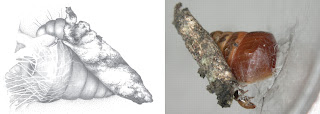 If you're wondering what a mussel looks like between being ripped from its mooring and cooked in a paella, here's your answer*. This is one of the mussels (farmed Mytilus edulis) from yesterday's lab class. I opened it with that well-known fine dissecting tool, the Stanley knife. All I did was cut through the posterior adductor muscle and then, once the shells started to gape, through the smaller anterior adductor as well. Luckily, it's not brain surgery.
If you're wondering what a mussel looks like between being ripped from its mooring and cooked in a paella, here's your answer*. This is one of the mussels (farmed Mytilus edulis) from yesterday's lab class. I opened it with that well-known fine dissecting tool, the Stanley knife. All I did was cut through the posterior adductor muscle and then, once the shells started to gape, through the smaller anterior adductor as well. Luckily, it's not brain surgery.(Bivalve shells are hinged with a band of protein and held closed by the adductor muscles. When the muscles relax or are damaged or when the animal dies, the shells open.)
Mussels glue themselves to rocks and timber with the byssus. This is a skein of protein threads, which adhere to hard surfaces. The byssus is produced as a liquid by the byssal gland and sets into strands as it is manipulated by the foot. (The byssal threads of the Mediterranean Pinna have been used to make cloth. When cleaned they have a golden sheen.)
 The mantle is a layer of tissue with more functions than you can poke a scalpel at. One of them is secreting the shell. Different regions of the mantle produce different parts of it—the nacreous (mother-of-pearl) lining, the main part and the thin outer covering of protein (periostracum).
The mantle is a layer of tissue with more functions than you can poke a scalpel at. One of them is secreting the shell. Different regions of the mantle produce different parts of it—the nacreous (mother-of-pearl) lining, the main part and the thin outer covering of protein (periostracum).Ctenidia (gills) serve double duty as respiratory and feeding structures. Respiration is straightforward but feeding is a little more complicated. Mussels, like many other bivalves, collect suspended particles in the water. These form the biggest part of the diet. But there's a touch of Goldilocks about these animals. The gills are covered in millions of cilia that sort the particles, rejecting those that are too big or too small and keeping only those that are just right. Unsuitable material is ditched in the form of pseudofaeces (you don't want to know), whereas the good stuff is passed along a food groove to the mouth.
 Each ctenidium is a sheet of filaments folded into a W. The filaments are connected to each other laterally by tufts of cilia and across each V by tissue. Under a microscope, ctenidia look like loosely-woven cloth. (You might be able to get an idea of this on the close up photo.)
Each ctenidium is a sheet of filaments folded into a W. The filaments are connected to each other laterally by tufts of cilia and across each V by tissue. Under a microscope, ctenidia look like loosely-woven cloth. (You might be able to get an idea of this on the close up photo.) Of course, there's more to a mussel than gills and byssus. There are guts and gonads, kidney, heart and ganglia—all too delicate to dissect without the proper gear and too tricky to photograph without an SLR. Next time, maybe.
_____
* I'd like to make an important distinction here. This mussel is dead. The ones that go into paella aren't.






























